Nepal Hazard Risk Assessment - Asia-Pacific Gateway for Disaster ...
Nepal Hazard Risk Assessment - Asia-Pacific Gateway for Disaster ...
Nepal Hazard Risk Assessment - Asia-Pacific Gateway for Disaster ...
You also want an ePaper? Increase the reach of your titles
YUMPU automatically turns print PDFs into web optimized ePapers that Google loves.
<strong>Nepal</strong> <strong>Hazard</strong> <strong>Risk</strong> <strong>Assessment</strong><br />
Premonsoon:<br />
During premosoon season, moisture index is positive over mid and high mountains of the east, central<br />
and western development regions except Jomsom district (moisture surplus over the northwest part of<br />
the country is not considered due to lack of representative station over that region: Figure 3.8d). Out of<br />
this, moisture surplus is highest over the eastern mountains and Lumle region (SMI > 20). Moisture<br />
index is negative over Tarai and Siwalik belts out of which Soil moisture deficit is highest over the<br />
Tarai/ Siwalik range of mid and far western development regions (SMI < -20). There is moisture deficit<br />
over rest of the far western, Midwestern and western parts of western development regions.<br />
Postmonsoon:<br />
This is the season of lowest rainfall in western regions of <strong>Nepal</strong>. Moisture index is predominantly<br />
negative (deficit) in this season. Except <strong>for</strong> Lumle region and far eastern portion of the country moisture<br />
index is deficit in rest of the country (Figure 3.10d). Except <strong>for</strong> Lumle positive values of SMI is confined<br />
below 5 in surplus regions where as over more than half of the country SMI is below -5.<br />
(b) Comparison of decadal and climatological moisture index<br />
Using the values tabulated in Table 3.8, decadal and climatological SMI maps are plotted. These maps<br />
are analyzed to assess the decadal fluctuation of SMI at different region in different seasons. This study<br />
is limited <strong>for</strong> the period of just over 3 decade so it doesn’t give a very clear picture of the decadal<br />
evolution of SMI but later studies can build on it and monitor the SMI variation over the long term in the<br />
context of climate change. In following section spatial pattern of three decadal moisture indices was<br />
compared against climatological moisture index <strong>for</strong> all seasons.<br />
Winter:<br />
Figure 6 shows that there is moisture surplus in largest portion of the country in the period 1988-1997<br />
while moisture deficit in largest portion of the country in the period 1988-2007 with the intermediate<br />
condition in 1977-1987 period. In 1977-1987 and 1988-1997 period highest positive amplitude of<br />
moisture index was observed in north-western part of the large portion of the country (SMI > 8)<br />
compared to 1998-2007. Likewise, moisture surplus is noted over the far western, large portion of mid<br />
western and parts of western region in 1977-1987, which extends further eastward and covers most of<br />
mid western and mountainous region in east and central region in 1988-1997 period. In 1998-2007<br />
period moisture deficit penetrated further westward and moisture surplus was confined to small region in<br />
far and mid western regions. Moreover, area with highest deficit (SMI < -4) covered larger geographical<br />
extent over Tarai and mid mountain in eastern region. These finding are again in agreement with decadal<br />
variation of probability of drought occurrence in winter as computed from SPI (Table 3.5), where the<br />
probability is least in 1988-1997 (which is almost equal that in the first decade) but increases sharply in<br />
the final decade.<br />
Premonsoon:<br />
Comparison of three decadal and climatological spatial pattern of premonsoon moisture index doesn’t<br />
depict considerable differences however some subtle differences are noted mainly over the western parts<br />
of the country (figure 7). In 1977-1987 decade there was mild moisture surplus in the northwest portion<br />
of the country which is absent in the following two decades, on the other hand out of three decades,<br />
magnitude of moisture surplus is highest in 1988-1997 decade over the Lumle region. The areal extent of<br />
severe moisture deficit was largest in the 1998-2007 decade and covered most of Tarai and Siwalik belts<br />
of far and mid western regions. These findings are not consistent with decadal variation of probability of<br />
drought occurrence in premonsoon as computed from SPI (Table 3.5), where the probability is least in<br />
1998-2007 and highest in 1988-1997.<br />
Monsoon:<br />
No significant change in moisture index is seen between the three decades and the climatology during<br />
monsoon season (Figure 3.9). This is apparently because of large magnitude of the moisture index and<br />
only small fluctuations in decadal mean. This is in line with the relatively constant probability of<br />
occurrence of monsoon drought <strong>for</strong> different decade and climatology as computed from SPI (Table 3.8).<br />
This is understandable as monsoon is the dominant system with excessive rainfall.<br />
Postmonsoon:<br />
This is the season with moisture deficit over almost the entire country with surplus in Lumle pocket and<br />
small parts of eastern region (figure 9). The areal extent and severity of moisture deficit is highest in the<br />
1988-1997 decade. Severity of moisture deficit is least in 1977-1987 decade and aerial extent of<br />
moisture surplus is also larger in this decade. The decade of 1998-2007 lies in between in terms of aerial<br />
extent and severity of moisture deficit. However, moisture surplus was of highest magnitude in the 1998-<br />
2007 decade over Lumle region. These finding are again in agreement with decadal variation of<br />
probability of drought occurrence in postmonsoon as computed from SPI (Table 3.5), where the<br />
probability is least in 1977-1987 but increased sharply in the 1988-1997 and finally dropped to almost<br />
the first decade value in the final decade.<br />
112
















